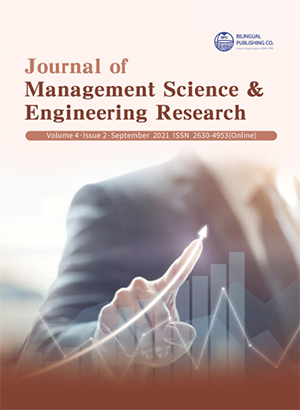-
5450
-
917
-
416
-
397
-
391
Inventory Management and Demand Forecasting Improvement of a Forecasting Model Based on Artificial Neural Networks
DOI:
https://doi.org/10.30564/jmser.v4i2.3242Abstract
Forecasting is predicting or estimating a future event or trend. Supply chains have been constantly growing in most countries ever since the industrial revolution of the 18th century. As the competitiveness between supply chains intensifies day by day, companies are shifting their focus to predictive analytics techniques to minimize costs and boost productivity and profits. Excessive inventory (overstock) and stock outs are very significant issues for suppliers. Excessive inventory levels can lead to loss of revenue because the company's capital is tied up in excess inventory. Excess inventory can also lead to increased storage, insurance costs and labor as well as lower and degraded quality based on the nature of the product. Shortages or out of stock can lead to lost sales and a decline in customer contentment and loyalty to the store. If clients are unable to find the right products on the shelves, they may switch to another vendor or purchase alternative items. Demand forecasting is valuable for planning, scheduling and improving the coordination of all supply chain activities. This paper discusses the use of neural networks for seasonal time series forecasting. Our objective is to evaluate the contribution of the correct choice of the transfer function by proposing a new form of the transfer function to improve the quality of the forecast.Keywords:
Inventory management; Demand forecasting; Seasonal time series; Artificial neural networks; Transfer functionReferences
[1] A. A. Syntetos and J. E. Boylan. On the bias of intermittent demand estimates. International Journal of Production Economics, 71(1) :457 466, 2001.
[2] A. Bacchetti and N. Babbie. Spare parts classification and demand forecasting for stock control: Investigating the gap between research and practice (1991), (6):722 -737, (2012). Special Issue on Forecasting in Management Science.
[3] A. Bakchir and J. E. Boylan, ‘’The accuracy of intermittent demand estimates,’’ International journal of Forecasting, Vol. 21, no.2, pp. 303-314, (2005).
[4] A. Candel, V. Parmar, E. LeDell, and A. Arora, Deep Learning, United States of America, (2018). A. Syntetos, Forecasting of intermittent demand, Brunel University, (2000). Berlin, Heidelberg, 2nd edition, 2018.
[5] C. Croston, “Exponential forecasting: some new variations,” Management Science, vol. 12, pp. 311- 315, 1969.
[6] C. Li and A. Lim, “A greedy aggregation-decomposition method for intermittent demand forecasting in fashion retailing,” European Journal of Operational Research, vol. 269, no. 3, pp. 860–869, (2018).
[7] Chen, K.Y. 2011. Combining linear and nonlinear model in forecasting tourism demand. Expert Systems with Applications, Vol.38, p 10368–10376.
[8] D. Gopika and B. Azhagusundari, “An analysis on ensemble methods in classification tasks,” International Journal of Advanced Research in Computer and Communication Engineering, vol. 3, no. 7, pp. 7423– 7427, (2014).
[9] G. Kushwaha, “Operational performance through supply chain management practices,” International Journal of Business and Social Science, vol. 217, pp. 65–77, (2012).
[10] G. Song and Q. Dai, “A novel double deep ELMs ensemble system for time series forecasting,” Knowledge-Based Systems, vol. 134, pp. 31–49, (2017)
[11] Grewal, A. L. Roggeveen, and J. Nordfält, “The Future of Retailing,” Journal of Retailing, vol. 93, no. 1, pp. 1–6, (2017).
[12] H. Biedermann. Ersatzteilmanagement: E- Ziente Ersatzteillogistik fur industrieuentern H. Tong, B. Liu, and S. Wang, “Software defect prediction using stacked denoising autoencoders and twostage ensemble learning,” Information and Software Technology, vol. 96, pp. 94–111, (2018).
[13] K. Yeo. Model-free prediction of noisy chaotic time series by deep learning. Computing Research Repository, abs/1710.01693, 2017.
[14] Kesten C. Green, J. Scott Armstrong 2012. Demand Forecasting Evidence-basedMethods. https://marketing .wharton.upenn.edu/profile/226/printFriendly.
[15] Mitrea, C. A., Lee, C. K. M., WuZ. 2009. A Comparison between Neural Networks and Traditional Forecasting Methods: A Case Study”. International Journal of Engineering Business Management, Vol. 1, No. 2, p 19-24.
[16] Shuai Wang, Lean Yu, Ling Tang, Shouyang Wang, 2011. A novel seasonal decomposition based least squares support vector regression ensemble learning approach for hydropower consumption forecasting in China. Energy Vol.36, p. 6542-6554.
[17] T. R. Willemain, C. N. Smart, and H. F. Schwarz. A new approach to forecasting intermittent demand for service parts inventories. International Journal of Forecasting, 20(3) :375 387, 2004.
[18] Wilamowski B. M. 2011. Neural Network Architectures. Industrial Electronics Handbook, vol. 5 – Intelligent Systems, 2nd Edition, chapter 6, pp. 6-1 to 6-17, CRC Press.




 Cisse Sory Ibrahima
Cisse Sory Ibrahima





